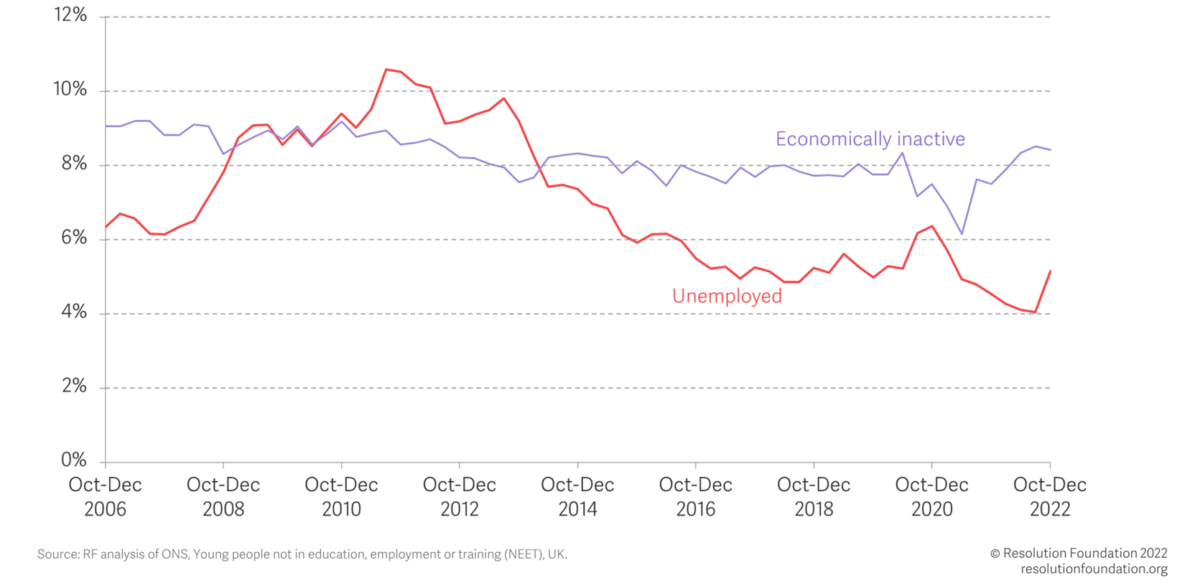Why Hasn’t the NEET Rate Budged? The Answer Lies in Early Intervention

The World of NEETs
I have just finished reading the Youth Employment 2024 Outlook report which shines a light onto the darkness of the world of NEETs in the UK. The report is published by Youth Futures Foundation, an independent organisation focused on improving employment outcomes for young people, and the headlines are that the number of young people aged 16-24 who are not in employment, education, or training (NEET) in the UK has remained stubbornly high for 20 years, highlighting a growing concern about the future prospects of the younger generations.
Statistics, Damn Statistics
The number of NEETs in the 16 to 24 age group has risen to almost 900,000, a significant increase compared to the same period last year, according to the Office for National Statistics (ONS), equating to 12.2% of all young people in this age bracket. That’s one in eight!

As you can see from the graph above, the percentage of all 16- to 24-year-olds who are NEET has remained pretty consistent for over a decade, steadily rising from 2018.
The NEET population comprises two main groups:

‘Economically inactive’ people are those who are not in the labour force, but are not considered unemployed, because they have not been looking for work within the last four weeks. The graph below shows that the number of young people in this category is considerably higher and stickier than those people who are unemployed and looking for work.

This picture is part of a broader trend of increasing economic inactivity across all age groups, with a total of 9.4 million people in the UK (this includes students), accounting for 22% of the population able to work, currently classified as ‘economically inactive’. That’s around one in five! There are lots of reasons why people might be inactive; they may be retired, stay-at-home parents, a carer or unable to work due to a disability or ill health. The current rise in inactivity is being driven by an increase in the number of people who are unable to work due to long-term sickness, which is at record high levels of 2.8 million. This may reflect outcomes for young people who have been NEET.
Understanding the Persistence in NEETs
Several factors have contributed to the stubborn high number of young people becoming NEETs.
Employer surveys have highlighted that companies struggle to fill vacancies due to not being able to find young people with the right skills for their business, referred to as the ‘skills gap’. This has been exacerbated post pandemic with many industries experiencing slow recovery or significant changes in employment practices. The increase in economic inactivity among young people highlights the ongoing challenges faced by the labour market in absorbing young workers.
Additionally, structural issues such as mental health problems, lack of skills, and inadequate access to support services are significant barriers. Poor mental health is one of the biggest obstacles, with the number of young people out of work due to ill health doubling over the past decade to around 190,000. Furthermore, specific demographic groups, including those with disabilities, from ethnic minorities, or with experience in the care system, face high risks of becoming NEET. For example, young people aged 19-21 with experience of being in the care system are about three and a half times more likely to be NEET!
There are also geographical disparities which also play a critical role in the NEET figures, reflecting regional economic inequalities and varying levels of access to education, training, and employment opportunities.
The Challenges and Consequences of Being NEET
The high percentage of NEETs comes at a huge cost. Both social and financial.
This raises urgent questions about the underlying causes, the broader societal impact, and the potential solutions to this issue.
Being NEET presents significant challenges for young people and has long-term negative consequences for individuals, for society and the economy. For young people, research shows that being NEET can lead to a range of adverse outcomes, including lower self-esteem, mental health issues, and a lack of social and professional networks, all of which can hinder the individual’s ability to find and maintain employment. This is what Dr. Andrea Barry, Principal Economist at Youth Futures Foundation, describes as “a tragedy”, pointing out that young people who drop out of school or take a long time to find a job are more likely to remain out of work or trapped in low-paid employment into adulthood – the vicious cycle which increases the risk of long-term economic disadvantage and social exclusion.
Broader Impact on the Economy
The big picture economic impact of a high NEET population is substantial. With fewer people in work or looking for work, and relatively high job vacancies, there are supply issues in the labour market, limiting productivity and the potential for economic growth.
According to Youth Futures Foundation, if the UK matched the NEET rate in the Netherlands, the lowest in the OECD, the full potential of young people could be unleashed, and GDP could be increased by £69bn in the long term.
There is also additional strain on social services and welfare systems, increasing public spending on benefits and healthcare. As a result, addressing the NEET crisis is not only a matter of supporting individuals but also a critical economic and social priority.
The Office for Budget Responsibility (OBR) has highlighted that the UK still has over 1% more people out of its workforce than in 2019. This has significant implications for the economy, such as reduced tax revenue which would come in very handy to support public services like the NHS and increased spending on welfare benefits; last year, government spending on Universal Credit alone reached a whopping £80.9 billion.
So, How Can We Address the NEET Crisis?: Potential Solutions
To address the rising number of NEETs, a multifaceted approach is required, involving collaboration between government, educational institutions, employers, and community organisations.
The UK government has acknowledged the complexity of the NEET issue and has proposed several measures to tackle it, including the creation of a new body, called Skills England, to address the skills’ gap, and the introduction of a Youth Guarantee to provide access to training, apprenticeships, and back-to-work support.
With a huge number of companies bemoaning the skills gap, there is a need for more targeted interventions to support those most at risk of becoming NEET. Youth Futures Foundation calls for better access to apprenticeships, particularly for those with lower levels of qualifications. Currently, many apprenticeships require Level 4 qualifications, which are above A-level, effectively excluding many young people who may benefit from such opportunities. One suggestion is that all apprenticeships should offer Level 2 or Level 3 entry requirements to widen access.
Community-based organisations and charities also play a crucial role in supporting at-risk youth. One example, Right to Succeed, based in North-West England, focuses on building personal relationships with young people most at risk of becoming NEET and providing tailored support to help them stay in education and develop career plans, essential in overcoming the personal and social barriers that many young people face.
Pathway and Purpose: Intervention Must Start Earlier
Despite numerous initiatives and policy changes, the number of young people in the UK classified as NEET has remained relatively unchanged over the last two decades. This enduring challenge implies that previous efforts have not adequately addressed the underlying issues.
Research indicates that many young people vulnerable to becoming NEET disengage during Key Stage 3. High levels of non-participation in education are often due to early detachment at school and a lack of diverse, interesting, practical learning options in the curriculum for students around age 14. This issue has been compounded by inconsistent and low-priority careers education and guidance, and insufficient support during key educational transitions, such as moving from primary to secondary school or from school to college. Opportunities to engage students with hands-on learning and meaningful activities linked to skills and character development are typically absent, further contributing to disengagement.
To make meaningful progress, there needs to be a shift in focus towards early pre-intervention strategies by engaging children at school in comprehensive skills’ development and meaningful exposure to employers at an early stage. Providing young people with diverse, practical, applied learning opportunities, better support during key educational transitions, and more accessible employability guidance can help to develop purpose and pathways and prevent disengagement before it even starts!
By Neil Wolstenholme, Chairman of Kloodle











Responses